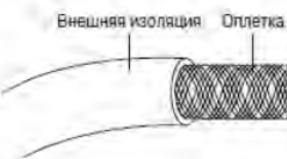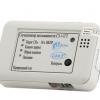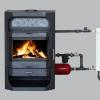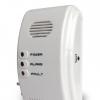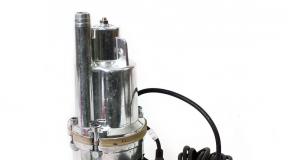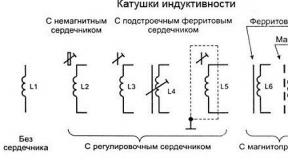Household device for checking the gas content of the room. A household gas detector is a device that can save your life. Shut-off valves and solenoid valves
Any room in which gas equipment is used must be checked for the level of concentration in the air of the products of combustion of gas. To measure this parameter and ensure safe conditions in everyday life and in industry, a special device is used - a gas sensor. What kind of device it is, what functions it performs, is disclosed in the article.
What is a gas sensor
This is a high-precision measuring device designed for continuous automatic monitoring of the amount of hazardous gases contained in the air. Gas alarms are used in industrial, household and communal premises.
They are produced as a separate device, which can be placed autonomously in a suitable place. There are also signaling devices included in the kit for shutoff valves.
The device is equipped with an analyzer capable of responding to changes in the concentration of certain gases. Various sensors are used to measure the amount of gas in the medium. They instantly respond to an increase in the concentration of gases emanating from gas appliances. At a high level of gas contamination, the sensor gives light and danger.
Modern models of sensors are equipped with a liquid crystal display, which displays the measured values. The built-in memory allows you to record the received data and store all measurement results.
Also, the display shows information about the device's performance and existing problems. This feature allows timely replacement of worn items.
Types of gas detectors
Gas control sensors are divided into two main types: household and industrial. Domestic use signaling devices provide a number of reactions to exceeding the set gas concentration parameter. The main tasks of an industrial sensor are to measure and display gas content indicators on the display. Industrial devices are used to solve more stringent problems and are often used in conjunction with a control panel, to which a signal is supplied from gas sensors.
According to the type of measured gas, signaling devices are distinguished:
- Methane.
- Propane.
- To measure or carbon monoxide.
- Combined multicomponent.
According to the installation method, gas sensors are:
- Stationary - work only from the mains and are located close to the power source.
- Portable - powered by a built-in battery.

Functionality of gas sensors
The gas contamination sensor is a multifunctional device and has the following features:
- Sound and light notification. If the device reacts to gas pollution, its indicator lights up and a loud sound signal is triggered.
- Possibility of connection of the gas cut-off valve.
- The presence of a relay output for connecting additional electrical devices: a separate siren, fan, mechanism for a fire or dispatcher console.
- Built-in autonomous power supplies.

Installation Features
The installation of a gas sensor depends on the type of device and is carried out subject to certain rules. Installation of a household signaling device can be carried out independently, following the manufacturer's instructions. Each sensor model comes with a passport with a device installation diagram.
When choosing a place for the device, it is better to seek help from representatives of the gas service. They know the regulations and can choose the right place.
Typically, gas alarms are placed on the wall near appliances that run on gas (near the column, gas stove, boiler and meter). The distance between the sensor and the gas appliance must not exceed 4 meters.
How not to install a gas sensor:
- Less than 1 meter away from ovens and gas burners.
- In places of high dustiness.
- Close to windows or ventilation ducts.
- Near places where gasoline, paints, solvents are stored.
- Near uninsulated chimneys.
Industrial signaling devices are installed by gas specialists using a special technology.

Gas detectors for the boiler room
Boilers and other thermal devices operate on liquid, gaseous and solid fuels, the combustion of which in industrial premises may produce an excess amount of methane and carbon monoxide. This threatens to poison personnel and cause an explosive situation. Gas sensors in the boiler room allow you to timely determine the high concentration of gases and prevent emergencies. All boiler rooms must be equipped with gas control alarms in compliance with the following requirements:
- the sensor must work continuously;
- the sensitivity of the device must be selective;
- the presence in the device of a program for switching on / off emergency ventilation until the concentration of methane and carbon monoxide reaches a normal value;
- alarms from several devices must be connected to a common remote control;
- availability of a certificate of conformity with GOST;
- The instrument must be of safe design and have the longest possible service life.

gas sensor cost
In each specialized store you can buy a gas sensor. The price of this device depends on the brand and functionality. Thus, a household signaling device for propane or methane produced by Promgazenergo costs almost 1.5 thousand rubles. An automatic gas pollution sensor from PKF Energosystems costs about 6 thousand rubles. It can be used in domestic and industrial premises. The price of imported models can exceed 10 thousand rubles.
What is a gas detector, what functions does it perform and how does it ensure safety? How does the signaling device work with additional devices, what is their cost and can I install them myself? You will learn about this and much more from this article.
What is a gas alarm
Gas detectors are devices that provide continuous monitoring of the content of combustible gases and carbon monoxide in the air of rooms where gas equipment is installed. Signaling devices have long been used in industry to ensure the safety of facilities, however, they have become relatively recently used in the gasification of residential buildings.

Types of signaling devices. Which to choose
Signaling devices are of two types: industrial and household.
More stringent requirements apply to industrial ones and often they work in conjunction with a control panel, which receives signals from several gas sensors and which provides control over the concentration of the measured parameter in the air. The requirements for a household sensor are not so strict. Its main task is not to measure and display the concentration, but to operate if the value of the controlled parameter exceeds the set value. Also, a household sensor should provide a number of reactions to gas contamination.
Gas detectors differ in the controlled parameter; for household sensors, three main types can be distinguished:
- methane (CH 4);
- propane (C 3 H 8);
- carbon monoxide (carbon monoxide, CO).
There are also combined sensors that simultaneously monitor the concentrations of combustible and carbon monoxide.
For a room in which gas-using heating equipment is installed, a combined sensor (CH 4 + CO or C 3 H 8 + CO) is best suited. For a room with stove heating, a carbon monoxide sensor will suffice.
When choosing a signaling device, it is necessary to take into account the power supply of the sensor and devices with which it will interact in case of operation, the best option is 220 V. The same power supply should be selected for related equipment, which will be discussed below.

Price table for gas detectors:
| Sensor type | Controlled parameter | Switching of external electrical networks | Shut-off valve control | Cost, rub. |
| SGB-1-2 | CH 4 - 0.1%, CO - 0.01% | - | - | 1269,00 |
| SGB-1-7 | CH 4 - 1%, CO - 0.005% | - | - | 1724,00 |
| Guardian of Mind | CH 4 - 0.5%, CO - 0.01% | - | - | 1282,00 |
| Guard 110UM | CH 4 - 0.5%, CO - 0.01% | + | + | 1638,00 |
| Guardian UM-005 | CH 4 - 0.5%, CO - 0.005% | - | - | 1387,00 |
| Guard 110UM-005 | CH 4 - 0.5%, CO - 0.005% | + | + | 1684,00 |
| SGB-1-2B | CH 4 - 0.1%, CO 0.01% | + | + | 1545,00 |
| SGB-1-7B | CH 4 - 1%, CO - 0.005% | + | + | 2073,00 |
| Varta 2-03 | CH 4 - 1%, CO - 0.005% | + | + | 2252,00 |
| Varta 2-03B | CH 4 - 1%, CO - 0.005% | - | - | 1850,00 |
| UKZ-RU-SN4-SO | CH 4 - 0.5%, CO - 0.002-0.01% | - | + | 5664,00 |
| SGB-1-4.01 | CO - 0.01% | - | - | 1159,00 |
| SGB-1-4,01B | CO - 0.01% | + | + | 1393,00 |
| UKZ-RU-SO | CO - 0.002-0.01% | - | + | 3658,00 |
| SGB-1-6 | C 3 H 8 - 0.46% | - | - | 1270,00 |
| SGB-1-6B | C 3 H 8 - 0.46% | + | + | 1504,00 |
| Maxi/C | CH4 - 1%, С3Н8 - 0.4%, CO - 0.005% | - | - | 1112,00 |
| Maxi/K | CH 4 - 1%, C3H8 - 0.4%, CO - 0.005% | - | + | 1421,00 |
What does the alarm respond to?
The value of the value of the controlled parameter in the air, at which the signaling device will work, is the same for most household sensors and is:
- Methane - 0.1-1%.
- Propane - 0.46-0.05%.
- Carbon monoxide - 0.005-0.01%.
The percentages of methane and propane are about five times less than the lower concentration limit of flame propagation for these gases. This means that the alarm will work much earlier than the gas content in the air reaches an explosive concentration.
What functions can a gas detector perform?
Household gas detectors, due to their design, are multifunctional devices. The list of possibilities of each signaling device is individual. Here are the main ones present in most sensors:
- light and sound notification. When gassed, the indicator light comes on and a loud sound signal appears;
- the ability to connect a solenoid gas shut-off valve;
- relay output, through which it is possible to connect electrical devices (exhaust fan, separate annunciator, signal to a fire or control panel, etc.);
- power outputs, for direct connection of additional equipment from the sensor;
- some sensors have the ability to work from an autonomous power source.

What is a solenoid valve. Its types
The solenoid shut-off valve is a device that is mounted at the gas pipeline inlet to the room and is a valve that, when an electrical signal is applied to its coil, must shut off the gas supply to gas appliances.
Shut-off valves differ in:
- nominal diameter. For domestic needs, valves Dn 15, 20, 25 are often used;
- nutrition. For domestic needs, optimally - 220 V;
- allowable pressure. For low pressure gas pipelines - up to 500 mbar;
- by valve type: normally open and normally closed.
The type of valve is the most significant characteristic for operation in combination with a gas detector.
A normally open (pulse) valve is a manually reset valve. During operation, no voltage is applied to its coil. When the gas alarm is triggered, a short-term electrical impulse comes to the valve coil from the sensor, causing the sensor to trigger and cut off the gas. The designation of this type of valve is N.A.

A normally closed valve is also a manually reset valve. However, in order to cock (open) it, it is necessary to apply voltage to its coil. When the gas alarm is triggered, the voltage on the coil disappears and the valve cuts off. The designation of this type of valve is N.С.

For domestic use, a normally open valve with a 220 V supply is more suitable. This is due to the fact that a power outage will not cause it to operate. This makes it possible to use non-volatile gas appliances (stove, column). There is also no need to waste energy to keep the valve open.
The only inconvenience with such a valve may arise if it works in conjunction with a gas sensor, which automatically checks the health of its outputs when the power is turned on. After turning on the power, such a sensor will send a pulse to the valve, as a result of which it will work. When choosing a sensor, it is necessary to carefully study the sequence of its operation.
Information on the type of valve, supply, allowable pressure and conditional passage is indicated on its label.

Cost of solenoid shut-off valve: type N.A., 220 V, Pmax: 500 mbar:
Installation and connection of the gas detector
Installation of a household gas detector can be done independently. To do this, it is necessary to correctly place the sensor, guided by the instructions in the passport, and supply power to it. It is also necessary to connect additional devices according to the scheme provided in the product passport.
In modern gasification projects, the installation sites of gas detectors and their number are indicated in the project documentation. Also, the gas service can provide assistance in choosing the right place to place the sensor, guided by regulatory documents.
The signaling device should be placed on a vertical wall, in places where the probability of gas leakage is greatest (near the boiler, column, gas meter, stove), at a horizontal distance of no more than 4 meters from the gas appliance.
Where not to place the alarm:
- at a distance closer than 1 meter from gas burners and ovens;
- in places where steam, ash, dust and grease can get on the signaling device;
- near ventilation ducts and open windows;
- in places where paint, solvents, gasoline and similar materials are stored;
- in the immediate vicinity of uninsulated chimneys.
It must be taken into account that for each type of signaling device (CH 4, C 3 H 8, CO or combined), the sensor mounting height will be different. This is due to the different density of air and gas, the area of its accumulation in the room:
- methane (CH 4) - not lower than 0.5 m from the ceiling;
- carbon monoxide (CO) - at a height of 1.8 m from the floor, or higher, but not closer than 0.3 m to the ceiling;
- combined sensor (CH 4 + CO) - in the range from 0.3 m to 0.5 m to the ceiling;
- propane (C 3 H 8) - no higher than 0.5 m from the floor. If there are pits, trenches and other recesses in the room where combustible gas can accumulate, it is also necessary to install an additional signaling device in them.
Fixing a household signaling device on the wall often does not even require opening the case. The sensor is attached to the dowels for the mounting holes in the housing.

Shut-off valve connection
The installation of the shut-off valve must be carried out exclusively by specialized organizations licensed for this type of work. The valve is connected to the signaling device according to the schemes indicated in the passports of the valve and the signaling device.
Alarm service. Costs for periodic verification
A gas detector installed in a residential building is practically maintenance-free. The only thing that is necessary is to periodically wipe the grill in the sensor housing from dust and cobwebs.
Once a year, the signaling device must undergo metrological verification. This service is paid. In no case is it allowed to independently check the operation of the signaling device by supplying a 100% gas mixture to it, for example, from a gas lighter. This can damage the sensitive element of the sensor.
It is advisable to purchase sensors from domestic manufacturers. This will allow, if necessary, to send the sensor for repair, which is much cheaper than buying a new one.
Remember that a gas alarm is an important and relatively inexpensive safety feature that could very well save your life one day. The choice is yours!
Dangerous properties of gas fuel:
- the ability of gas to form flammable and explosive mixtures with air;
- suffocating power of the gas.
The components of gas fuel do not have a strong toxicological effect on the human body, but at concentrations that reduce the volume fraction of oxygen in the inhaled air to less than 16%, they cause suffocation.
During the combustion of gas, reactions occur in which harmful substances are formed, as well as products of incomplete combustion.
Carbon oxide (carbon monoxide, CO)- formed as a result of incomplete combustion of fuel. A gas boiler or water heater can become a source of carbon monoxide if there is a malfunction in the combustion air supply and flue gas removal path (insufficient draft in the chimney).
Carbon monoxide has a highly directed mechanism of action on the human body up to death. In addition, the gas is colorless, tasteless and odorless, which increases the risk of poisoning. Signs of poisoning: headache and dizziness; there is tinnitus, shortness of breath, palpitations, flickering before the eyes, redness of the face, general weakness, nausea, sometimes vomiting; in severe cases, convulsions, loss of consciousness, coma. Air concentrations greater than 0.1% result in death within one hour. Experiments on young rats have shown that a concentration of CO in the air of 0.02% slows down their growth and reduces activity compared to the control group.
Gas alarm - gas leak sensor, is it necessary to install
Since 2016, building regulations (clause 6.5.7 of SP 60.13330.2016) require indoor new residential buildings and apartments in which gas boilers, water heaters, stoves and other gas equipment are located, install gas alarms for methane and carbon monoxide.
For existing buildings this requirement can be seen as a very useful recommendation.
The methane gas detector serves as a leakage sensor for household natural gas from gas equipment. The carbon monoxide alarm is triggered in case of malfunctions in the chimney system and the ingress of flue gases into the room.
Gas sensors should be triggered when the gas concentration in the room reaches 10% of the natural gas LCVRP and the CO content in the air is more than 20 mg / m 3.
Gas detectors must control a quick-acting shut-off (cut-off) valve installed at the gas inlet to the room and shutting off the gas supply by the signal of the gas contamination sensor.
The signaling device must be equipped with a built-in system for giving a light and sound signal when triggered, and / or turn on an autonomous signaling unit - a detector.
The installation of signaling devices allows you to notice a gas leak and malfunctions in the operation of the smoke exhaust path of the boiler in time, prevent fire, explosion, poisoning of people in the house.
NKPRP and VKPRP - this is the lower (upper) concentration limit of flame propagation - the minimum (maximum) concentration of a combustible substance (gas, vapors of a combustible liquid) in a homogeneous mixture with an oxidizing agent (air, etc.) at which flame propagation through the mixture is possible at any distance from source of ignition (open external flame, spark discharge).
If the concentration of a combustible substance in the mixture is less than the lower limit of flame propagation, such a mixture cannot burn and explode, since the heat released near the ignition source is not enough to heat the mixture to the ignition temperature.
If the concentration of a combustible substance in the mixture is between the lower and upper limits of flame propagation, the ignited mixture ignites and burns both near the ignition source and when it is removed. This mixture is explosive.
If the concentration of a combustible substance in the mixture exceeds the upper limit of flame propagation, then the amount of oxidizing agent in the mixture is insufficient for complete combustion of the combustible substance.
The range of concentration values between NKPRP and VKPRP in the "combustible gas - oxidizer" system, corresponding to the ability of the mixture to ignite, forms an ignitable region.
Gas detector for LPG
The building regulations do not contain mandatory requirements for the installation of gas alarms in rooms when using liquefied gas. But liquefied gas alarms are commercially available and installing them will undoubtedly reduce the risks for you and your loved ones.
Scheme of automatic control and protection against gas pollution in a private house
Schematic diagram of automatic control and protection against gas contamination in the boiler room of a private house: 1 - carbon monoxide gas contamination alarm; 2 - signaling device for natural gas; 3 - shut-off valve on the gas pipeline; 4 - gas boiler or water heater; 5 - a detector in the house, notifies the inhabitants of the house with light and sound.Gas control systems for premises with automatic shutdown of the gas supply in residential buildings should be provided when installing gas equipment, regardless of the installation location and its power.
 Gas alarm in the kitchen with a gas stove: 1 - natural gas alarm; 2 - shut-off valve on the gas pipe.
Gas alarm in the kitchen with a gas stove: 1 - natural gas alarm; 2 - shut-off valve on the gas pipe.  Schematic diagram of automatic control and protection against gas contamination of apartments in an apartment building
Schematic diagram of automatic control and protection against gas contamination of apartments in an apartment building
How to choose the right gas alarm for your home
 A set of equipment for an automatic protection system against gas contamination of a house, apartment. The set includes: carbon monoxide alarm, natural gas alarm, gas pipe shut-off valve, connecting wires.
A set of equipment for an automatic protection system against gas contamination of a house, apartment. The set includes: carbon monoxide alarm, natural gas alarm, gas pipe shut-off valve, connecting wires. To protect your home from gas pollution, you should choose a set of equipment specially designed for installation in a residential building or apartment. Such a household kit will not cause difficulties in coordinating the parameters of individual elements of the automatic gas control system. In addition, the equipment will be best adapted to work in domestic conditions, to be used by personnel without special training.
In the kitchen only with a gas stove carbon monoxide alarm can be omitted.
Gas protection equipment must have permits, Russian passport, certificate and/or declaration of compliance with the technical regulations of the Customs Union (Customs Union), allowing its use in the gas sector of Russia and other countries of the Customs Union.
When choosing a set of equipment, it is necessary to take into account not only its cost, but also costs for subsequent operation:
- Compare the total equipment life specified in the factory documentation for systems from different manufacturers. At the end of its service life, the safety equipment must be replaced.
- The service life of sensors - sensitive to gas elements, is usually less than the total service life of gas detectors. Sensors have to be changed frequently. Estimate the cost of replacing sensors in equipment from a particular manufacturer.
- In the passport of the signaling device there should be a special mark on the passage of the metrological verification by the device. Otherwise, you will still have to pay for the verification of the device before putting it into operation. Such a mark is an extra guarantee that the purchased device is in good working order.
- The gas protection system needs to be tested regularly - to check its serviceability and readiness for action. Choose equipment that is tested at the touch of a button.
- I recommend choosing signaling devices with the ability to connect a backup autonomous power supply, for example, a battery or an accumulator.
In addition, gas alarms for houses and apartments choose:
- by type of gas to be determined: natural gas (methane, CH 4), liquefied gas (propane-butane), carbon monoxide (carbon monoxide, CO);
- sensitivity (threshold) : 10% LEL for gas fuel, 20 mg / m 3 for carbon monoxide;
- according to the type of sensor - a sensor sensitive to gas: the operation of sensors for the same gas can be implemented on different physico-chemical principles: optical, chemical, thermocatalytic;
- by service life, frequency of sensor replacement: 3 years, 5 years, the more the better;
- by the service life of the device: at least 10 years;
- for additional functions, for example, there are devices with a GSM module for instant notification of a gas leak using SMS and push notifications directly to a smartphone; devices with self-diagnosis and fault indication; devices with additional contacts for controlling other external devices - switching on an exhaust fan or an additional detector.
Shut-off electromagnetic shut-off valve for the gas pipeline
Can be connected to a gas sensor three types of shut-off valves with manual or automatic reset:
- Normally closed valves - shut off the gas supply when the gas sensor is triggered and when the power is turned off.
- Normally open valves - shut off the gas supply only when the sensor is triggered (the gas supply does not stop in the event of a power outage)
- Pulse valves - the valve is held in the open position by a mechanical latch. If a short current pulse is applied to the solenoid coil from the gas contamination detector, the latch is released and the valve closes. The signaling device can generate a control pulse of electric current, both in the presence of a supply voltage, and at the moment of its disconnection.
The return (cocking) of the valves to the open position after actuation is performed manually (manual-cocked valves) or automatically (auto-cocked valves).
In private houses and apartments, gas alarms with a pulse valve and manual cocking are usually installed. This is an easier and cheaper option.
Normally open valve with manual cocking works as follows. Before starting work, it is necessary to supply electricity to the signaling device, then manually cock the normally open valve to open it.
The valve solenoid coil is de-energized in this rest position. The valve is held in the open position by a latch. Therefore, in the event of a power outage and after its re-supply, the valve remains open. Thus, the gas supply does not stop when the voltage is switched off and on.
In case of detection of gas contamination, the contacts of the signaling device are closed, voltage is applied to the valve solenoid, the latch releases the valve and it closes. After the disappearance of gas pollution, the contacts of the signaling device open, the signaling device automatically switches to normal operation. But to open the valve, you need to cock it manually.
Normally closed valve with manual cocking works as follows. Before starting work, it is necessary to supply electricity to the signaling device. The electromagnetic coil of the valve is energized through the normally closed contacts of the signaling device. Then you need to manually cock the valve.
In this initial position, the valve is held open by an electromagnet whose coil is permanently energized. In the event of a power outage, the valve closes and after re-applying power, the valve must be manually re-cocked.
In the event of gas contamination, the contacts of the signaling device open, voltage is lost from the valve electromagnet and it closes. After the disappearance of gas pollution, the contacts of the signaling device are closed, voltage is applied to the electromagnetic coil of the valve, the signaling device automatically switches to normal operation. But to open a normally closed valve, you need to cock it manually again.
Shut-off gas valve with electrical impulse control
 Household gas detectors are usually designed to operate with a pulse controlled gas shut-off valve. The valve is held in the open position by a mechanical latch. The latch is released and the valve closes if a short current pulse is applied to the solenoid coil from the gas contamination detector. The signaling device can generate a control pulse of electric current, both in the presence of a supply voltage, and at the moment of its disconnection.
Household gas detectors are usually designed to operate with a pulse controlled gas shut-off valve. The valve is held in the open position by a mechanical latch. The latch is released and the valve closes if a short current pulse is applied to the solenoid coil from the gas contamination detector. The signaling device can generate a control pulse of electric current, both in the presence of a supply voltage, and at the moment of its disconnection.
If a closing impulse comes to the valve from the signaling device both when the gas contamination sensor is triggered and when the power is turned off, then the valve operation algorithm corresponds to normally closed.
If the signaling device sends an impulse to close the valve only on the signal of the gas contamination sensor, the valve operates as normally open. In the event of a power outage, the valve does not shut off the gas supply.
The operation algorithm of such a valve can be changed by changing the corresponding gas alarm settings.
How to choose the right shut-off valve
When choosing a set of equipment, the shut-off valve is selected according to the following parameters:
- diameter of the gas pipe at the valve connection point: 1/2″ (D at 15), 3/4″ (D at 20), 1″ (D at 25), 1 1/4 "(D at 32), 1 1/ 2 "(D at 40), 2" (D at 50);
- according to the normal position of the valve: normally open or normally closed;
The type of valve, normally open or closed, is selected from the following considerations:
For gas boiler or water heater, which stop working in the event of a power outage and automatically resume work after applying voltage, on the gas pipeline install normally open valve.
On a gas pipeline for a gas stove, as well as a boiler or column, whose operation does not depend on the presence of voltage in the mains, a normally closed valve is mounted. Such a valve will shut off the gas supply during the absence of electricity in the house. This is necessary, because during a power outage, the gas pollution alarm will not work and the house, the apartment will be left without its protection.
In order not to feel discomfort from the lack of electricity and gas in the house, it is recommended to connect the gas detector to the mains through a UPS - an uninterruptible power supply.
Installation, installation of a gas alarm
The installation of gas alarms in a house or apartment can be carried out by organizations and individual entrepreneurs admitted to these types of work.
 Recommended locations for gas detectors in the kitchen
Recommended locations for gas detectors in the kitchen Gas alarms are installed on the wall of the room, near the gas equipment. Gas sensors should not be placed in blind areas where there is no air circulation, behind cabinets. For example, it is recommended to install the device no closer than 1 m. from the corners of the room. In addition, it is forbidden to install devices in the immediate vicinity of supply and exhaust ventilation devices, from heat sources.
The signaling device for natural gas (methane, CH 4) is mounted in the upper zone, at a distance of no more than 30 - 40 cm. from the ceiling, as this gas is lighter than air.
Signaling devices for liquefied gas (propane-butane), which is heavier than air, are installed below, at a height of approximately 30 cm. from the floor.
For carbon monoxide, the detector is recommended to be installed in the working area of a person, at a height of 1.5 - 1.8 m. from the floor. The density of this gas is approximately equal to the density of air. Carbon monoxide is heated from the boiler into the room. Therefore, the gas rises up to the ceiling, cools and is distributed throughout the entire volume of the room. A carbon monoxide detector may be installed near the ceiling, next to the same device for methane. Given this circumstance, some manufacturers produce a universal gas alarm that reacts immediately to both gases - methane and carbon monoxide.
Shut-off solenoid shut-off valve is installed on the gas pipe, in a place convenient for access to the manual cocking button.
The installation of a shut-off valve on the gas pipeline should include:
- in front of gas meters (if a disconnecting device at the input cannot be used to turn off the meter);
- in front of household gas appliances, stoves, water heaters, heating boilers;
- at the entrance of the gas pipeline to the room, when a gas meter with a disconnecting device is placed in it at a distance of more than 10 m. from the entry point.
 Some models of gas detectors, in addition to the shut-off valve on the gas pipeline, can control the activation of an additional light and sound detector or an electric fan in the ventilation duct.
Some models of gas detectors, in addition to the shut-off valve on the gas pipeline, can control the activation of an additional light and sound detector or an electric fan in the ventilation duct. Gas detector operation
Metrological verification of the gas content sensor performed once a year, as well as after replacing the sensors. Verification is performed by a specialized organization that has the appropriate permission to carry out such work.
 Test - a cylinder with a calibration gas mixture for testing and checking the operation of a gas alarm. Designed for 70 tests.
Test - a cylinder with a calibration gas mixture for testing and checking the operation of a gas alarm. Designed for 70 tests. Once every six months a check is made of the operation of the signaling device from a test gas mixture containing a certain percentage of the test gas. It is forbidden to test the device with, for example, gas from lighters, because. this can lead to failure of the sensing element.
The "TEST" button is designed to test the light and sound detectors, as well as to test the operation of the gas shut-off valve.
Within the period specified in the factory documentation, sensor needs to be replaced— sensor sensitive to gas. After replacing the sensor, the alarm threshold is adjusted and the instrument is subjected to metrological verification. The work of replacing the sensor should be entrusted to a specialized organization.
Gas alarm - gas leak sensor with manipulator
 Kit, gas alarm with electric ball valve on the gas pipe. The size of the gas cock manipulator bracket for mounting on a 1/2″ or 3/4″ or 1″ pipe.
Kit, gas alarm with electric ball valve on the gas pipe. The size of the gas cock manipulator bracket for mounting on a 1/2″ or 3/4″ or 1″ pipe. On sale you can find sets of gas alarms with an electric ball valve manipulator on a gas pipe. The electric manipulator of the gas valve is fixed on the gas pipe with the help of a special bracket. The rotary lever of the manipulator is connected to the handle of a standard ball valve installed in front of a gas stove, boiler or column. At the command of the signaling device, the electric motor of the manipulator will turn the lever and the handle of the gas valve to the closed position within 3-7 seconds and shut off the gas supply. The tap can be opened or closed manually by pulling the retaining ring and releasing the lock.
Easy installation. There is no need to touch the existing gas circuit, install a solenoid valve. Installation can be done independently, without resorting to calling gas service specialists. Before buying though I advise you to coordinate the installation of the manipulator with the gas service with which a maintenance contract has been concluded. Find out how they will react to your amateur performances. And then, at the next check, they may require you to remove the device.
Proper installation of the manipulator - the axis of rotation of the arm of the manipulator must be above the axis of rotation of the ball valve.
The option with a manipulator instead of a gas valve is allowed for installation in already built houses and apartments.
Manipulators have complex electromechanics and are stuffed with electronics. They may not have Russian passports and certificates allowing their use. The signaling devices that are included in the kit are also often sold without a Russian passport, metrological verification and certificate. The reliability of the gas protection system with a manipulator is inferior to a similar system with a gas valve.
In newly constructed houses, the requirements of the rules should be followed and certified systems with gas alarms and a shut-off valve on the gas pipe should be installed. This is the best choice for old houses and apartments.
Gas alarm and leakage sensor without gas valve
 Gas detector, gas leak sensor plugged into electrical outlet. The device beeps, the LED flashes, the gas supply does not turn off.
Gas detector, gas leak sensor plugged into electrical outlet. The device beeps, the LED flashes, the gas supply does not turn off. There are a large number of different brands of gas detectors and gas leakage sensors on sale, the design of which does not provide for the connection and control of a gas shut-off valve. Such signaling devices, when triggered, emit light and sound signals and even send SMS messages to a smartphone, but the gas supply is not blocked.
Installation of such devices, without a shut-off gas valve, is simpler and cheaper. The signaling device for the home master can be installed independently, without calling the gas service specialists. But it should be understood that the reliability of protecting your home and family members from fire, explosion or poisoning, with such equipment, will be much worse. Besides, the protection system will not comply with the requirements of current regulations.
Often such devices are sold without the necessary documentation or they do not comply with the requirements of the regulations. There are no metrological verification, certificates, the service life of devices and replacement of sensors is not indicated, the threshold of their operation is unknown. There are problems with the warranty and service, replacement of sensors.
Watch a video about a household gas alarm from one of the Russian manufacturers:
Gas alarms in your city
Gas alarm. Household gas leak sensor. Gas leak alarm.
For reliable protection of the house from gas contamination, the correct design and operation of ventilation systems is very important.
When a kitchen hood is attached above the stove to the only channel in the kitchen natural ventilation, then the filters, valves and fan in the kitchen hood practically block the natural draft in the ventilation duct.
The kitchen with the hood turned off remains without ventilation, which impairs air exchange throughout the house and creates a threat of gas accumulation in the room.
A powerful explosion brought down the entrance of an apartment building in the city of Volgograd, located at 60 Universitetsky pr. 4 people died, eleven more were hospitalized in serious condition. The cause of the collapse was an explosion of household gas in one of the apartments of the ill-fated entrance. One of the residents simply forgot to close the burner handle on the stove ...
Similar messages appear in news feeds with enviable regularity. You wonder why people learn only from their mistakes and do not want to use the bitter experience of others? Modern gas stoves have smart burners - with a fire attenuation sensor. There is a fire - there is a supply, there is no fire - the gas supply stops. Convenient and safe.
But! Old stoves are completely unsafe. The classic - "and your milk ran away" can lead to disaster and the demolition of the whole entrance - as happened in the story above.
By installing an inexpensive gas alarm in the kitchen, half of these dramas could be avoided. Long before a dangerous concentration is exceeded, a sensitive sensor will trip and give a loud warning signal.
Gas alarm - what is it?
A gas analyzer or gas leak detector is a device that determines dangerous concentrations of certain volatile fractions in the air. Signal the presence of methane CH 4, propane C 3 H 8, carbon monoxide CO.
Design
Structurally, the vast majority of household gas alarms are made in the form of a monoblock - the sensor, the control module and the power supply are enclosed in a common housing. Sometimes the sensors are taken out from the control unit for a certain distance. But such designs are several times more expensive and are extremely rare.
The gas analyzer needs a tiny amount of power. Typically, devices require only a few watts to operate. Kenaryu GD100, for example 3 watts. Gas analyzer HONEYWELL 6618B 2 W, Dajet MT8085 4 W.
Very often, power is provided by a 220V network, through the socket into which the device is connected. Sometimes, for reliability, they provide power supply from an autonomous source. These can be 9V or 12V batteries.
Types of sensors and principle of operation
The heart of any gas analyzer is, of course, the gas sensor. They are different in design. They differ in measurement accuracy, activation speed, life cycle period and cost.
 Semiconductor. The principle is as follows - when a controlled gas is exposed to a platinum filament, the resistance changes. Work from -20°C. Accuracy 0.001%. The sensor initialization time is no more than 2 minutes. They are small in size at a relatively low cost. The most popular type of sensor in household gas detectors. In terms of accuracy, they lose a lot to electrochemical sensors.
Semiconductor. The principle is as follows - when a controlled gas is exposed to a platinum filament, the resistance changes. Work from -20°C. Accuracy 0.001%. The sensor initialization time is no more than 2 minutes. They are small in size at a relatively low cost. The most popular type of sensor in household gas detectors. In terms of accuracy, they lose a lot to electrochemical sensors.
However, in Europe, control standards are getting tougher all the time. The use of semiconductor sensors will soon be discontinued due to their low accuracy.
 Electrochemical. Estimation of gas concentration is issued according to the degree of the electrochemical process. Actually, this gave the name to this type of sensor.
Electrochemical. Estimation of gas concentration is issued according to the degree of the electrochemical process. Actually, this gave the name to this type of sensor.
Features: very high measurement accuracy, ideal instrument for analyzing the concentration of certain gas fractions. They have a great resource of work. They are used in high-precision signaling devices in production. Where high resistance to vibration and shock is required.
 infrared. Concentration analysis is performed based on the results of infrared irradiation of the incoming gas. At the moment, they are considered the most accurate sensors.
infrared. Concentration analysis is performed based on the results of infrared irradiation of the incoming gas. At the moment, they are considered the most accurate sensors.
They have only one drawback - the high price, compared with electrochemical and semiconductor ones.
Methane, propane, carbon monoxide
Carbon monoxide CO
 Molecular weight = 28. Almost equal to the weight of air, slightly lighter (28 vs. 29).
Molecular weight = 28. Almost equal to the weight of air, slightly lighter (28 vs. 29).
There is no other poison that would kill more people as a result of poisoning. Carbon monoxide is the absolute champion. Poison, colorless and odorless. Upon contact with carbon monoxide, the body does not recognize it as a foreign agent, and does not turn on defenses. On the contrary, it “opens its arms” towards the invisible killer. Carbon monoxide displaces oxygen, a person dies from hypoxia. He just falls asleep, not realizing what is happening to him.
Installation: at the height of human growth.
Methane CH4
 Molecular weight = 16, lighter than air.
Molecular weight = 16, lighter than air.
I. Explosive. Refers to toxic substances acting on the central nervous system. Colorless gas, odorless. In everyday life, they are enriched with odorants so that a person notices a leak in time. They are used to supply gas to household stoves in apartments. Often referred to as natural gas, trunk gas. Leakage of methane is the main cause of explosions in apartments and entire porches in apartment buildings with gas stoves.
Installation: a meter from the ceiling.
Propane C3H8
 Molecular weight = 58, heavier than air.
Molecular weight = 58, heavier than air.
I. Explosive, flammable. Has a specific smell. Refers to toxic substances acting on the central nervous system. It is used in everyday life to supply gas for portable stoves from liquefied gas cylinders.
Installation: a meter from the floor.
Installation locations
Carbon monoxide and propane sensors are installed - no higher than 25 cm from the floor, methane - under the ceiling. Not less than 35 cm from the ceiling. Why this is so is clear from the description of the chemical properties of hazardous gases. Sensors should be located in places of their possible concentration. Everything is simple.
Sometimes there are combined detectors, for example - methane + carbon monoxide. It is better to avoid them and take two separate ones. Place carbon monoxide at the height of human growth, and methane - under the ceiling. There will be much more sense.
 Examples of installation of household gas analyzers in the kitchen
Examples of installation of household gas analyzers in the kitchen Shut-off valves and solenoid valves
 Obviously, the process of closing the gas pipe can be automated. Often a solenoid valve is installed on the pipe. As soon as the signaling device determines the danger, the siren immediately turns on and the valve cut-off is triggered - the pipe is reliably blocked, the main gas supply is stopped. This can be a great help when misfortune happened at the time of your absence.
Obviously, the process of closing the gas pipe can be automated. Often a solenoid valve is installed on the pipe. As soon as the signaling device determines the danger, the siren immediately turns on and the valve cut-off is triggered - the pipe is reliably blocked, the main gas supply is stopped. This can be a great help when misfortune happened at the time of your absence.
Estimates and reviews of cutters are different. Many are afraid of the unreliability of such devices, considering such a measure difficult and dangerous. And they are limited to installing only a signaling device.
Installing solenoid valves is indeed a difficult procedure. You will not be able to install a cut-off device in the house on your own. You will need to call a gas specialist. By the way, before purchasing a valve, you need to know the diameter of the line. They come in ½ or ¾ inches.
 Gas contamination detector "Kenar GD100". It can be installed anywhere. If desired, cut-offs 1/2 or 3/4 are connected
Gas contamination detector "Kenar GD100". It can be installed anywhere. If desired, cut-offs 1/2 or 3/4 are connected Conclusion
Take care of yourself. Your family, loved ones. There is nothing more valuable than your life. Honestly!

CHOOSE A HOUSEHOLD GAS DETECTOR.
We are increasingly thinking about the safety of our property and protecting our health, the question arises how to do this?
For automatic continuous monitoring of the presence of explosive and toxic gases in domestic and communal premises, it is necessary to install
HOUSEHOLD GAS DETECTOR.
There is currently a wide range of household gas alarms. Neither become popular. They can often be found in houses and apartments. For a nominal amount, you can purchase an excellent certified device that will continuously monitor the presence of dangerous and toxic gases in the room (such as natural gas (Methane CH4,) liquefied fuel gas (Propane C3H8) or carbon monoxide (Carbon monoxide, Carbon monoxide, CO). Installing a signaling device will eliminate the possibility of an explosion of accumulated combustible gases and further spread of flames, poisoning of people in the room with large concentrations of toxic gases due to leakage, depressurization of gas pipelines, attenuation of the burner flame, reverse draft, etc. Carbon monoxide control signaling device, as an additional , can be used as a fire gas detector to detect fires in the early stages of their occurrence.
What is the working principle?
The principle of operation of the device is based on the passage of air, by natural convection, through the sensitive elements built into the signaling device. In case of exceeding  permissible concentrations of hazardous and toxic gases, above the thresholds, the signaling device gives an emergency sound signal, disconnects the equipment from the gas supply line, turns on the hoods, light signal displays, sirens, transmits an alarm signal via GSM communication channels, through additionally installed signal transmission devices. After the gas supply is stopped and its concentration in the air drops to normal, the sound signal will stop, auxiliary devices will turn off, and the indicator will return to the measurement mode. After eliminating the cause of the alarm (leakage, burner damping, reverse draft, etc.), independently or by the gas service, depending on the malfunction, it will be necessary to restart the disconnected heating or heating equipment.
permissible concentrations of hazardous and toxic gases, above the thresholds, the signaling device gives an emergency sound signal, disconnects the equipment from the gas supply line, turns on the hoods, light signal displays, sirens, transmits an alarm signal via GSM communication channels, through additionally installed signal transmission devices. After the gas supply is stopped and its concentration in the air drops to normal, the sound signal will stop, auxiliary devices will turn off, and the indicator will return to the measurement mode. After eliminating the cause of the alarm (leakage, burner damping, reverse draft, etc.), independently or by the gas service, depending on the malfunction, it will be necessary to restart the disconnected heating or heating equipment.
What are household gas alarms?
The designs of household gas detectors are usually standard. Sensing elements are built into the signaling device (monoblock version) or taken out  outside (remote sensors). Devices are single-component or two-component, i.e. can simultaneously control the concentrations of natural and carbon monoxide in the air (two-component) or one of them (single-component). Signaling devices with remote gas sensors have one or two measurement channels. Each channel is connected to one of the necessary gas contamination control sensors, in which sensitive elements are built. For example, a sensor for monitoring the presence of natural gas (Methane CH4,) in the room air is connected to one measurement channel, and a carbon monoxide control sensor (Carbon monoxide, Carbon monoxide, CO) is connected to the second channel or the same sensors are installed on all channels. Signaling devices with remote sensors allow remote control of gas contamination of premises at distances up to 200 m. As an example, this can be a basement where a boiler room is installed, and there is a need for visual control of what is happening in the basement from a residential floor, in this case a two-channel signaling device will be convenient gas type SG-1. Sometimes there are several possible sources of leaks or gas accumulations located at a distance from each other, where the rules require the installation of gas monitoring sensors. In these cases, it is advisable to install several monoblock signaling devices, such as SGB-1, and connect all devices to one gas valve or other actuator. The housing of the signaling device is usually plastic, compact. Different manufacturers can have any shape and color - be guided by your preferences and harmonious fit into the interior. The signaling device is installed on the fasteners supplied with the device. The device is connected to a household AC 220V mains, in some models of signaling devices, for uninterrupted operation, the option of automatic switching to backup power in cases of power failure (outage) is installed, for this, backup power supplies with automatic recharging of the IRP-1 type are installed, also there are devices powered by built-in batteries. It is more expedient to use devices powered by AC 220V, so
outside (remote sensors). Devices are single-component or two-component, i.e. can simultaneously control the concentrations of natural and carbon monoxide in the air (two-component) or one of them (single-component). Signaling devices with remote gas sensors have one or two measurement channels. Each channel is connected to one of the necessary gas contamination control sensors, in which sensitive elements are built. For example, a sensor for monitoring the presence of natural gas (Methane CH4,) in the room air is connected to one measurement channel, and a carbon monoxide control sensor (Carbon monoxide, Carbon monoxide, CO) is connected to the second channel or the same sensors are installed on all channels. Signaling devices with remote sensors allow remote control of gas contamination of premises at distances up to 200 m. As an example, this can be a basement where a boiler room is installed, and there is a need for visual control of what is happening in the basement from a residential floor, in this case a two-channel signaling device will be convenient gas type SG-1. Sometimes there are several possible sources of leaks or gas accumulations located at a distance from each other, where the rules require the installation of gas monitoring sensors. In these cases, it is advisable to install several monoblock signaling devices, such as SGB-1, and connect all devices to one gas valve or other actuator. The housing of the signaling device is usually plastic, compact. Different manufacturers can have any shape and color - be guided by your preferences and harmonious fit into the interior. The signaling device is installed on the fasteners supplied with the device. The device is connected to a household AC 220V mains, in some models of signaling devices, for uninterrupted operation, the option of automatic switching to backup power in cases of power failure (outage) is installed, for this, backup power supplies with automatic recharging of the IRP-1 type are installed, also there are devices powered by built-in batteries. It is more expedient to use devices powered by AC 220V, so
